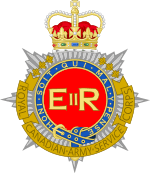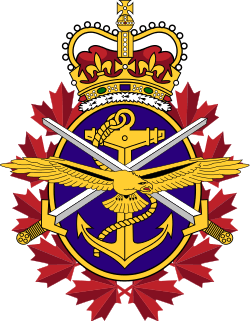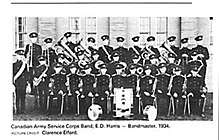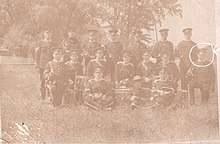Royal Canadian Army Service Corps
The Royal Canadian Army Service Corps (RCASC) was an administrative and transport corps of the Canadian Army. The Canadian Army Service Corps was established in the Non-Permanent Active Militia in 1901, and in the Permanent Active Militia in 1903.[2] The Canadian Permanent Army Service Corps was redesignated The Royal Canadian Army Service Corps on 3 Nov 1919.[3]
| Royal Canadian Army Service Corps | |
|---|---|
 The badge of the Royal Canadian Army Service Corps | |
| Active | 1 November 1901 – 1 February 1968 |
| Country | |
| Allegiance | |
| Branch | |
| Type | Corps |
| Role | (Canadian Army) Permanent Active Militia |
| Motto(s) | Nil Sine Labore (Latin, "Nothing Without Work") |
| March | Wait for the Wagon[1] |
History


The RCASC was established by General Order No. 141, as the Canadian Army Service Corps (CASC), on November 1, 1901. The CASC was modelled directly off the British Army Service Corps to provide all transportation and supply services to the Army. Initially, the CASC consisted of four companies to support the Active Militia units. The Corps grew quickly, doubling the number of units by 1903, and growing by another three companies by 1905. By the summer of 1914 the CASC had a strength of 3000 personnel in eighteen companies.[4]
During World War I, the CASC provided a support element for each Canadian Division, and later on, for the Canadian Corps. With the introduction of motorized vehicles, the CASC carried commodities of a greater range and of greater weights. Motorized transportation also resulted in expanded responsibilities such as driving ambulances and engineer pontoon vehicles, carrying all natures of ammunition, and mobile repair and recovery. In recognition of the services rendered during the Great War, His Majesty King George V authorized the designator “Royal” in 1919.[4]
The RCASC, along with the rest of the Army, underwent a rapid expansion as Canada mobilized for the Second World War. In addition to maintaining transport for the army on land, the RCASC also commanded and maintained a ship-borne freight and patrol company, the Pacific Command Water Transport Company, during World War II. The RCASC provided support to Canadian Soldiers wherever they went; training in Canada and Great Britain, the campaign in north-west Europe, (see: British logistics in the Normandy Campaign ), and in the campaign in Italy. The RCASC moved supplies from the rear areas to the front-lines. They delivered all rations, ammunition, petroleum products, and all other essentials. They did so with a variety of vehicles ranging from three to ten ton trucks, and forty ton tank transporters.[4]
During the 1950s, the RCASC committed No. 1 and No. 2 Movement Control Groups, 54 Canadian Transport Company, 28 Motorized Ambulance Company, and 58 General Transport Company to the Korean War. In 1952, 23 Transport Company relieved 54 Transport Company, which was in-turn relieved by 56 Transport Company. 3 Transport Company was the last to serve in Korea in 1954. 4 Transport Company (previously known as 56 Transport Company and then 5 Transport Company) moved from Winnipeg to Calgary in August 1967. In June 1968, 4 Transport Company combined with elements of the static 13 Transport Company. Three months later that organization became the Transport Company of 1st Service Battalion.[4]
Unification
| Part of a series on the |
| Military history of Canada |
|---|
 |
| Military history of... |
| Conflicts |
|
| Installations |
| Lists |
|
|
When the Army, Royal Canadian Navy, and Royal Canadian Air Force were merged in 1968 to form the Canadian Forces, the administrative Corps of the Army were deactivated and merged with their Naval and Air Force counterparts to form the Canadian Forces' personnel branches.[5]
- The RCASC's transport and supply elements were combined with the Royal Canadian Ordnance Corps to form the Logistics Branch
- The RCASC's clerical trades were merged with the Royal Canadian Army Pay Corps and the Royal Canadian Postal Corps to form the Administration Branch (later merged with the Logistics Branch) [6]
- Until the formation of the Service Battalions in September 1968, all transportation service was provided by the Royal Canadian Army Service Corps.
RCASC units overseas 1945
1st Armoured Brigade
- 1st Armoured Brigade Company
2nd Armoured Brigade
- 2nd Armoured Brigade Company
1st Infantry Division
- 1st Infantry Divisional Troops Company
- 1st Infantry Brigade Company
- 2nd Infantry Brigade Company
- 3rd Infantry Brigade Company
2nd Infantry Division
- 2nd Infantry Divisional Troops Company
- 4th Infantry Brigade Company
- 5th Infantry Brigade Company
- 6th Infantry Brigade Company
3rd Infantry Division
- 3rd Infantry Divisional Troops Company
- 7th Infantry Brigade Company
- 8th Infantry Brigade Company
- 9th Infantry Brigade Company
4th Armoured Division
- 4th Armoured Divisional Troops Company
- 4th Armoured Divisional Transport Company
- 4th Armoured Brigade Company
- 10th Infantry Brigade Company
5th Armoured Division
- 5th Armoured Divisional Troops Company
- 5th Armoured Divisional Transport Company
- 5th Armoured Brigade Company
- 11th Infantry Brigade Company
1st Corps Troops
- 1st Headquarters Corps Car Company
- 1st Corps Transport Company
- No. 31 Corps Troops Company
- No. 32 Corps Troops Company
2nd Corps Troops
- No. 2 Headquarters Corps Car Company
- 2nd Corps Transport Company
- No. 33 Corps Troops Company
- No. 34 Corps Troops Company
First Canadian Army Troops
- No. 1 Army Headquarters Car Company
- No. 35 Army Troops Composite Company
- No. 36 Army Troops Composite Company
- No. 81 Artillery Company
- No. 82 Artillery Company
- No. 41 Army Transport Company
- No. 45 Army Transport Company
- No. 47 Army Transport Company
- No. 63 Army Transport Company
- No. 64 Army Transport Company
- No. 1 Motor Ambulance Convoy
- No. 2 Motor Ambulance Convoy
General Headquarters, Line of Communication and Base Troops
- No. 66 General Transport Company
- No. 69 General Transport Company
- No. 1 Base Transport Company
- No. 65 Tank Transporter Company
- No. 85 Bridge Company
- No. 86 Bridge Company[7]
RCASC units in Korea and Japan 1950-1955
Korea
- No. 54 Canadian Transport Company (4 May 51 - 11 Apr 52):
- No. 23 Transport Company (10 Apr 52 - 27 Mar 53):
- No. 56 Transport Company (22 Mar 53 - 15 Apr 54):
- No. 3 Transport Company (26 Mar 54 - 27 Nov 54):
Japan
- No. 57 General Transport Company (1 Dec 52 – 26 Feb 53) redesignated No. 58 General Transport Company 27 Feb 53 – 4 Jan 55
- No. 2 Canadian Movement Control Group (7 Oct 50 –4 Jan 55) [8]
Bands


The RCASC sported multiple military bands during its 67 year history. The full dress uniform at the time was the army's dress blues accompanied by a white pith helmet. The original band wore a khaki uniform, however the commanding officer arranged for a dress blue uniform.
The following is a list featuring the organization of RCASC bands in the past:[9]
- Royal Canadian Army Service Corps Brass and Reed Band
- Royal Canadian Army Service Corps Bugle Band
- Royal Canadian Army Service Corps Apprentice School Bugle Band
- Band of the 5th Column, Royal Canadian Army Service Corps (Toronto)
- No. 49 "Tipper" Company (High River)
- 153 Company, 7 Column, RCASC (High River)
The Calgary units of the RCASC formed a band in 1932, with its first public performance was being on 12 March 1933 at Strand theatre. Many band members went overseas in 1940 and a new trumpet and drum band was formed at Sarcee Barracks to replace this band. The latter was dissolved at the end of the war and a new RCASC band was organized by George Bealing in 1948. By the end the summer of 1942, the band mainly consisted of musicians from the depleted ranks of the West Canadian Collieries Band.[10] This band officially disbanded in 1963, with most remaining members transferring to The King's Own Calgary Regiment Band.[11] On 2 September 1939, the RCASC Trumpet Band marched through the streets of Ottawa with accompanying placards that was designed tro recruit Canadian volunters following the declaration of war on Nazi Germany.[12]
The 5th Column RCASC Trumpet Band from Toronto was the RCASC predecessor to the then Jolly Jesters and the modern day Burlington Commanders Drum Corps. At the time of its active service, it was part of the army reserve. In 1955, the army forbade the band from performing at a civilian function in Toronto. As a result, the band nade the decision to remove itself from the army order of battle and become a civilian group.[13][14][15]
Notable RCASC bandsmen included the following officers and personnel:
- Peter John Powers, founder of a local unit band and former National President of the Federation of Musicians for Canada.[16]
- J. Alan Wood
- Alexander D. Knight Jr, former member of the RCASC trumpet band and former Vice President/business manager of the Toronto Signals Band.[17]
- George Edward Jardine, Canadian authors[18]
- Ted Reilly, Drum Major of the RCASC Toronto Band and founder of the Jolly Jesters.
Armoury
| Site | Date(s) | Designated | Description | Image |
|---|---|---|---|---|
| Colonel D. V. Currie VC Armoury, 1215 Main Street North, Moose Jaw, Saskatchewan |
1913-14 | 1998 Register of the Government of Canada Heritage Buildings |
|
|
See also
References
- http://rcasc.org/w84wgn.html Royal Canadian Army Service Corps March Past
- http://www.cmhg.gc.ca/cmh/page-587-eng.asp Canadian Military Life After South Africa
- The Regiments and Corps of the Canadian Army (Queen's Printer, 1964)
- Arnold Warren, Wait for the Waggon. The Story of the Royal Canadian Army Service Corps. McClelland and Steward Limited, 1961.
- http://rcasc.org/ Royal Canadian Army Service Corps
- Sutton, Brigadier John, ed.," Wait For The Waggon". Barnsley, South Yorkshire: Leo Cooper, 1998.
- Canada. Dept. of National Defence Bond, C. C. J Stacey, C. P. (Charles Perry), 1906-1989. The victory campaign: the operations in North-West Europe, 1944-1945 / by C. P. Stacey ; maps drawn by C.J. Bond. Ottawa: Queen's Printer, 1960.
- Wood, Herbert Fairlie. Strange Battleground: The Operations In Korea and Their Effects On The Defence Policy of Canada; Official History Of The Canadian Army (In Korea). Ottawa Queen's Printer, 1966
- http://www.dcxmuseum.org/assets/15%2520-%2520Canadian%2520Military%2520Drum%2520and%2520Bugle%2520Corps.pdf&ved=2ahUKEwjYy_DJu6znAhWIbs0KHVtbDRcQFjAMegQIAhAB&usg=AOvVaw2p9l-GZYX4FDm3EkT4dJFS
- http://www.dvrbs.com/history-mil/FrankHosek.htm
- Calgary, University of; Laval, Université. "Our Roots - Page view". Retrieved 2017-10-23.
- https://www.ottawamatters.com/remember-this/remember-this-ottawa-at-war-1670866
- https://www.optimists-alumni.org/jolly_jesters.htm
- http://images.ourontario.ca/waterloo/31441/data
- http://dcatchorus.ca/media/newsletter/1999/May-99.pdf&ved=2ahUKEwjf55yHka7nAhUJbq0KHa7iDHMQFjAPegQICRAB&usg=AOvVaw1yxAKJpAD7DNxyn6KeY-Rs
- https://www.thechronicleherald.ca/obituaries/peter-john-power-18349/
- http://www.knightsinfo.ca/military.html
- https://books.google.com/books?id=yqOQRbcRMrAC&pg=PA332&dq=Royal+Canadian+Army+Service+Corps+Band&hl=en&sa=X&ved=0ahUKEwizhczAi6jnAhWPaM0KHa3JA-cQ6AEIJzAA#v=onepage&q=Royal%20Canadian%20Army%20Service%20Corps%20Band&f=false
| Wikimedia Commons has media related to Royal Canadian Army Service Corps. |